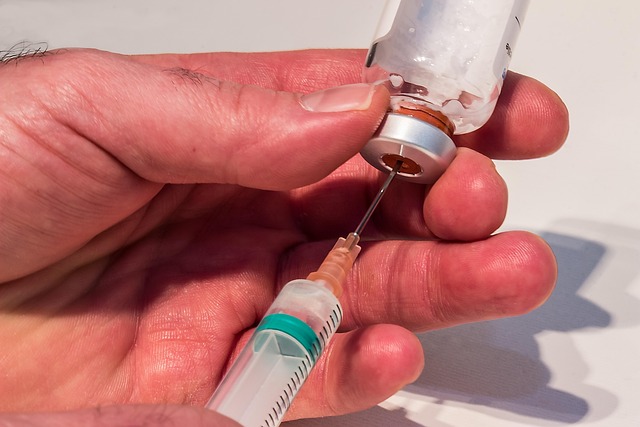GLP-1 receptor agonists (GLP-1 drugs) are synthetic hormones that mimic natural GLP-1 to regulate blood sugar in type 2 diabetes patients. They stimulate insulin secretion and inhibit glucagon release, offering a safe alternative with reduced hypoglycemia risk. Clinical trials show superior glycemic control compared to placebo and standard medications, with some GLP-1 drugs also providing cardiovascular benefits. These drugs have shown promise in weight management by reducing appetite and lowering body weight. However, they can cause gastrointestinal side effects like nausea and diarrhea, requiring careful consideration and monitoring under healthcare guidance. Future research aims to enhance their effectiveness and convenience, potentially expanding their use beyond diabetes for obesity and non-alcoholic fatty liver disease.
GLP-1 receptor agonists (GLP-1 drugs) have emerged as a powerful class of medications in diabetes management, offering significant improvements in blood glucose control. This article delves into the clinical outcomes associated with these innovative drugs. We explore their mechanism of action, types, and efficacy in managing blood glucose levels, while also examining their impact on cardiovascular health and role in weight management. Common side effects are discussed, along with patient considerations. Finally, we look to the future, highlighting research directions that promise even greater advancements.
GLP-1 Receptor Agonists: An Overview of Their Mechanism and Types

GLP-1 receptor agonists (GLP-1 RAs) are a class of drugs that mimic the effects of the natural hormone glucagon-like peptide-1 (GLP-1), which plays a key role in regulating blood sugar levels. Their primary mechanism involves stimulating insulin secretion and inhibiting glucagon release, leading to improved glycemic control. This action is particularly beneficial for individuals with type 2 diabetes, as it helps lower blood sugar without increasing the risk of hypoglycemia.
There are several types of GLP-1 RAs, each with its own unique structure and pharmacokinetic properties. These include exenatide, liraglutide, semaglutide, and dulaglitide. Exenatide, for example, is a synthetic version of exendin-4, a hormone found in the saliva of Gila monster lizards. Other GLP-1 RAs are fully human proteins designed to mimic the natural peptide. Each variant offers potential advantages in terms of dosing frequency, efficacy, and side effects, contributing to their growing use in diabetes management and potentially expanding their role in clinical practice.
Clinical Efficacy in Blood Glucose Control

GLP-1 receptor agonists, or GLP-1 drugs, have shown remarkable clinical efficacy in blood glucose control for individuals with type 2 diabetes. These medications mimic the effects of the natural hormone glucagon-like peptide-1 (GLP-1), which stimulates insulin secretion and suppresses glucagon release in a glucose-dependent manner. As a result, GLP-1 drugs help lower blood sugar levels effectively while minimizing hypoglycemia risks.
Several clinical trials have demonstrated that GLP-1 receptor agonists lead to significant reductions in HbA1c (average blood glucose over the past 2–3 months) compared to placebo or other standard diabetes medications. Some of these drugs, like liraglutide and semaglutide, have been approved by regulatory bodies for type 2 diabetes treatment due to their superior glycemic control and cardiovascular benefits.
Impact on Cardiovascular Health

GLP-1 receptor agonists have shown promising effects on cardiovascular health, one of the most significant side benefits of these drugs. Several clinical trials have demonstrated that GLP-1 drugs can reduce major adverse cardiovascular events (MACE) in high-risk patients with type 2 diabetes. This reduction is attributed to their ability to lower blood pressure, improve endothelial function, and decrease inflammation, all of which contribute to a healthier heart and reduced risk of heart disease.
Moreover, GLP-1 agonists have been linked to a lowering of LDL (bad) cholesterol levels and an increase in HDL (good) cholesterol, further enhancing cardiovascular protection. These drugs’ multifaceted benefits make them a valuable addition to diabetes management, offering not only improved glycemic control but also potential long-term heart health advantages.
Weight Management and Satiety Signals

GLP-1 receptor agonists, a class of drugs used to treat type 2 diabetes, have shown promising effects in weight management. These medications work by mimicking the actions of natural gut hormones, GLP-1, which signal satiety and reduce appetite. This leads to decreased food intake and subsequent weight loss. Clinical studies have demonstrated that GLP-1 drugs can help individuals achieve a meaningful reduction in body weight compared to placebo or other standard treatments.
The impact on satiety is a key mechanism behind their success. By activating receptors in the brain, these agonists enhance feelings of fullness, making people eat less and more mindfully. This dual action—controlling blood sugar levels and managing appetite—makes GLP-1 receptor agonists not only effective for diabetes management but also as potential tools in the fight against obesity and its associated health risks.
Common Side Effects and Patient Considerations

GLP-1 receptor agonists, or GLP-1 drugs, have shown significant promise in improving clinical outcomes for individuals with type 2 diabetes and obesity. However, like any medication, they come with potential side effects that patients should be aware of before starting treatment. Common adverse events associated with GLP-1 drugs include gastrointestinal symptoms such as nausea, vomiting, diarrhea, and abdominal pain, which are usually mild and transient but can sometimes lead to discontinuation of therapy. These drugs may also cause respiratory infections, headache, dizziness, and hypoglycemia, particularly when used in combination with other diabetes medications.
Patient considerations are essential when taking GLP-1 drugs. Individuals should discuss their medical history, current medications, and any concerns with their healthcare provider. Those with a history of gastrointestinal disorders, pancreatitis, or thyroid problems should exercise caution since these conditions may impact the safety and efficacy of treatment. Additionally, patients should be educated about the importance of regular monitoring, including blood sugar levels and potential weight changes, to ensure optimal clinical outcomes with minimal side effects.
Future Perspectives and Research Directions

The future of GLP-1 receptor agonists (GLP-1 drugs) holds immense promise in diabetes management and beyond. Ongoing research aims to optimize existing treatments, focusing on improving their efficacy, duration of action, and reducing adverse effects. One area of interest is the development of long-acting, once-weekly or even once-monthly GLP-1 drugs, offering greater convenience for patients while maintaining consistent blood sugar control.
Additionally, scientists are exploring the potential of GLP-1 therapies in treating other metabolic disorders, such as obesity and non-alcoholic fatty liver disease (NAFLD). Studies investigating the role of GLP-1 in appetite regulation and hepatic lipid metabolism may unveil new therapeutic avenues. Furthermore, combining GLP-1 drugs with other diabetes medications or lifestyle interventions could lead to more comprehensive and personalized treatment strategies, ultimately improving long-term patient outcomes.
